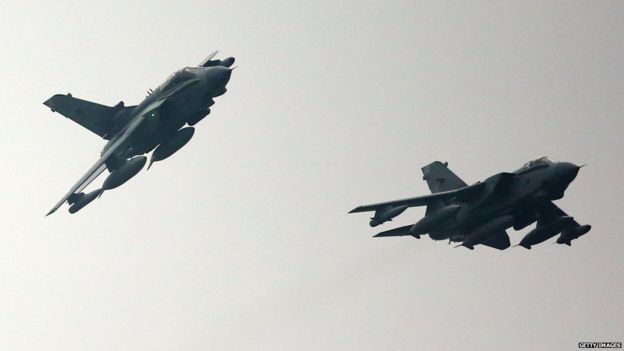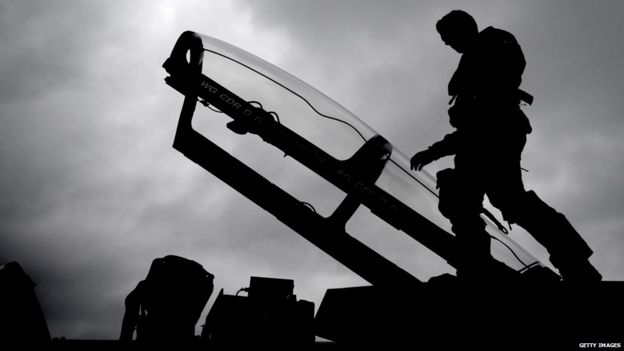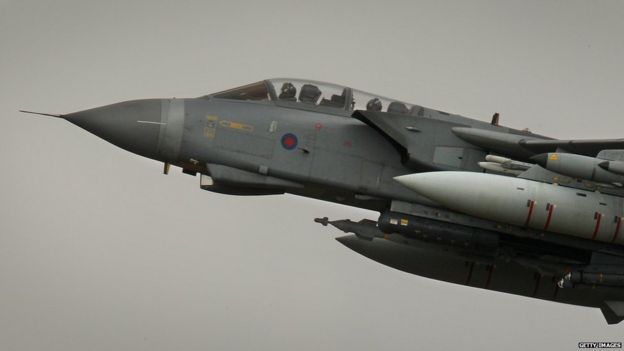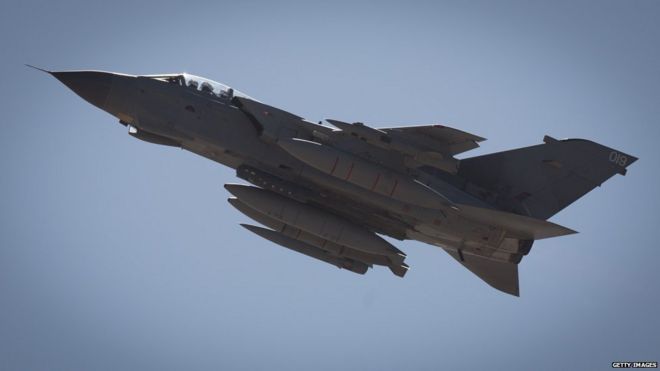- 5 August 2015
- From the section Magazine
The
RAF Tornado mission in Iraq, which was supposed to be disbanded last
March, will be extended until "at least" March 2017. Why has this
veteran Cold War combat jet proved so enduring?
The cockpit of a supersonic Tornado attack bomber is a much more peaceful place than you might expect."It's incredibly quiet," says Jas Hawker, a former RAF wing commander who flew the aircraft over Iraq and Kosovo. "The pilot and the navigator could drop their oxygen masks and talk to each other. It's not silent but it's a lot quieter than people think."
It also has a rather retro feel, as befits a four-decade-old model approaching the end of its time in service. "It's still full of 1980s dials," says Hawker. There isn't the array of screens you might see in more modern fighters, he adds.
Despite this, it's just been given a new lease of life.
But then Prime Minister David Cameron announced the Tornados' mission would continue until March 2016, and on Tuesday Defence Secretary Michael Fallon announced it would be extended by a further year.
It's a distinction for an aircraft that was conceived in the late 1960s, flew for the first time in 1974 and entered service in 1980. The RAF's Tornado fleet is due to retire in 2019, the date having been brought forward from the original deadline of 2025.
The jet is very much a product of its era. The Panavia Tornado was developed jointly by the UK, Germany and Italy to fly low and fast, avoiding Soviet air defences. Over time its bombing capacity was developed.
Compared with the Typhoon, which entered service with the RAF as recently as 2007, the much older Tornado is less manoeuvrable, having been primarily designed to fly quickly in straight lines at a low level.
But the GR4 has a major advantage over the newer model, says Nick de Larrinaga, Europe editor of IHS Jane's Defence Weekly: "They can carry the Brimstone air-to-surface missile which the RAF has found very useful." These are designed to minimise collateral damage and are capable of hitting moving targets.
Because the Tornado is a relatively large aircraft, it can carry a lot of these - 12 in four sets of three. As yet, the Typhoons are not equipped to carry them. Until Brimstone can be integrated with the newer jet, the GR4 has an advantage.

The GR4 is also equipped with Reconnaissance Airborne Pod for Tornado (Raptor), a sensor that is capable of taking highly detailed images day or night.
While the Eurofighter Typhoon project has faced delays and overspends since it was conceived in 1984, the Tornado remains a dependable aircraft. In the RAF, it is also popular with pilots.
"It's actually quite easy to fly," says Hawker. It's computerised and has hydro-mechanical flight controls. The variable-sweep wings, which allow the pilot to configure the wings according to flying speed, are swiped backwards and forwards manually. The two-seat cockpit is fairly spacious in comparison with other combat aircraft, although crews can be strapped to their seats for up to eight hours at a time during missions.
But, Hawker says, the large number of sensors can be difficult to operate - this is generally done by the navigator in the rear seat.
There were different versions of the Tornado. The British developed an air defence version, the F3, to intercept Russian bombers, which was retired in March 2011 and replaced with the Typhoon. There was also a reconnaissance variant, the GR1A, which was superceded by the GR4A, and an anti-shipping model, the GR1B. Germany and Italy also had an electronic combat/reconnaissance (ECR) version.
It's the interdictor/strike (IDS) variant that is currently flying missions from Cyprus to Iraq. Originally designated the GR1, some 228 entered service in the early 1980s and 142 of these were upgraded to being GR4s between 1997 and 2003.
Some 60 GR1s took part in Operation Granby, the British military deployment during the 1991 Gulf War. Six of them were lost. RAF Pilot John Peters and navigator John Nichol were paraded in front of cameras by their Iraqi captors after their Tornado was shot down . The two flight lieutenants were held captive for a total of 47 days.

RAF Tornado GR4 specifications
- Engines: Two RR RB199 Mk103 turbofans
- Thrust: 16,000lb each
- Max speed: 1.3 Mach
- Length: 16.72m
- Max altitude: 50,000ft
- Span: 8.6m
- Aircrew: Two

In 2010, the coalition government's Strategic Defence and Security Review concluded that the Harrier GR7/GR9 should be retired and that the Tornados could be the RAF's main strike aircraft until the Typhoon was ready to assume the role.
For all that it was conceived during the Cold War, the Tornado has proved remarkably effective at modern warfare, where targeted air attacks are a key part of military action, says de Larrinaga.
"If you go back to the RAF during World War Two, they would count a hit as any bomb within five miles of the target," he says. "Five metres would be considered a miss these days. The emphasis is really on precision."
But as aircraft grow older they become more expensive to repair, hence the gradual phasing out of the Tornado in favour of the Typhoon.
While there are plenty of pilots still trained to fly them, there are fewer Tornado navigators since the RAF stopped training them in 2009, says defence analyst Paul Beaver. Nonetheless, the GR4 remains popular with those who fly and operate it.
"The crews like it because it's dependable," he says. "You press a button and it starts."

No comments:
Post a Comment